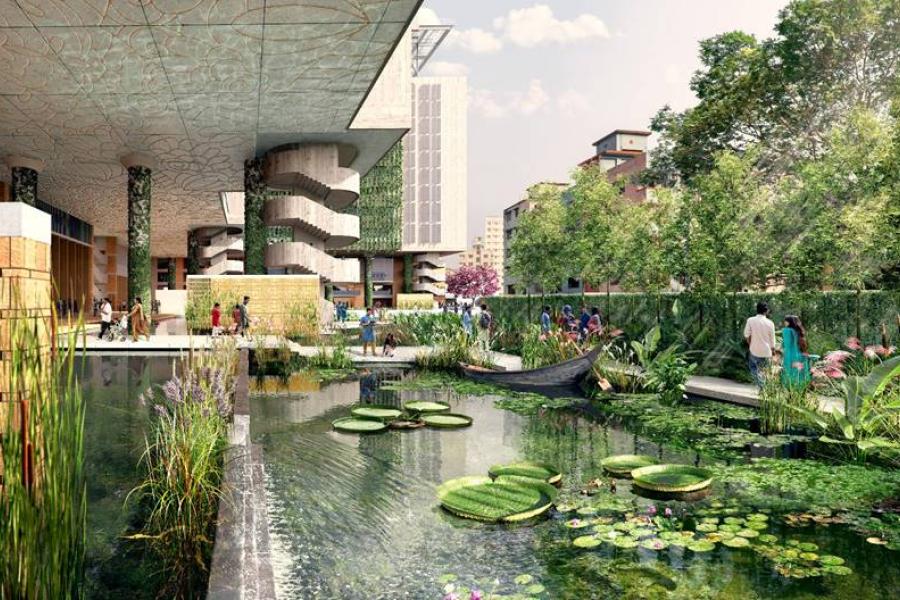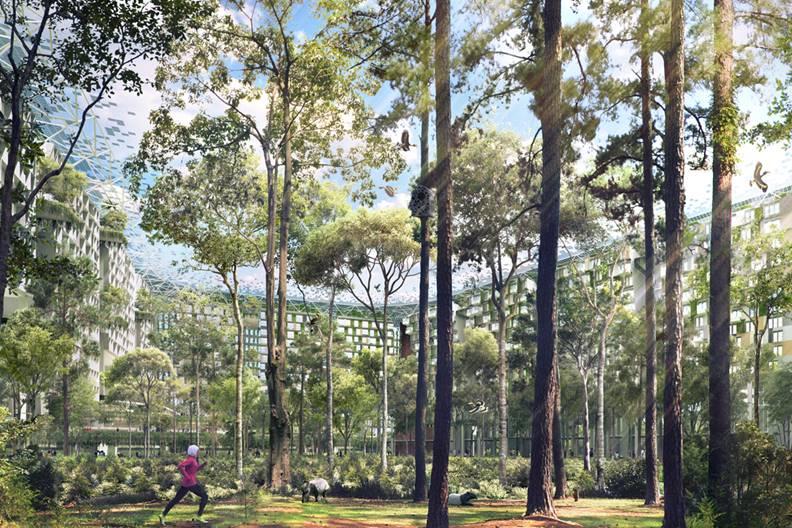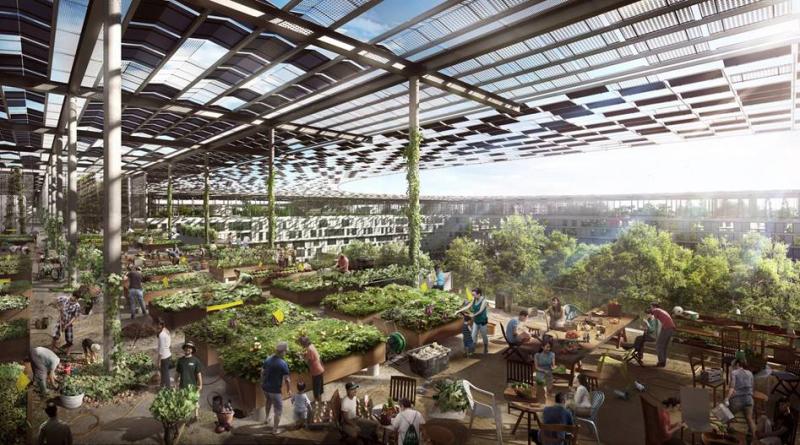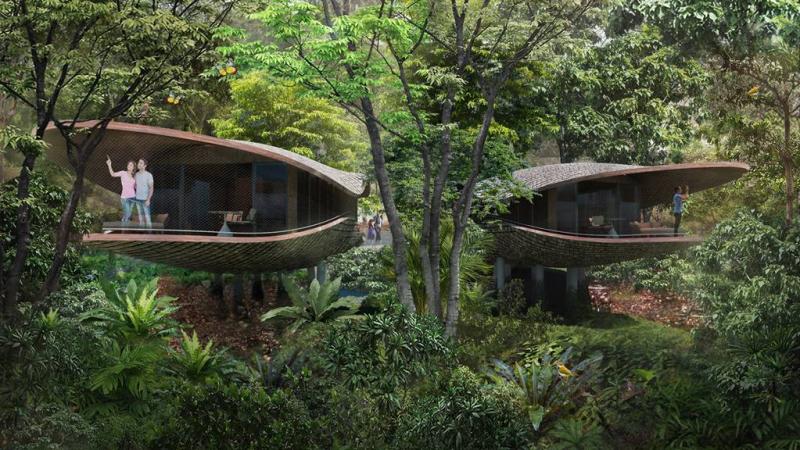SINGAPORE: CITY OF DESIGN, BY DESIGN EARTH DAY 2020
 Render of BRAC University by WOHA - Mit freundlicher Genehmigung von: camron
Render of BRAC University by WOHA - Mit freundlicher Genehmigung von: camronWas: Messe
Wann: 22.04.2020
Perhaps one of the greatest conjunctions of design, economic progress and quality of life has been Singapore’s commitment to bind its physical growth and infrastructure development to a literal green policy. And so, despite its 21st-century skyline, nearly half the island is covered in natural forest, mangrove reserves, and carefully tendered greenery. This is a remarkable expression of the vision of Singapore’s first Prime Minister and founding father, Lee Kuan Yew, that a major key to differentiate Singapore from its neighbours is to become the greenest and most liveable city in Asia; the idea being that people tend to thrive more when surrounded by nature. There is, after all, little point in being a commercially successful environment if it’s not that is also liveable. The city-state that has frequently been referred to as a “Garden City” became even more ambitious - now, urban planners and policy makers use the phrase “City in A Garden”, an acknowledgement of the primacy of nature in our urban environment.
Designing with greenery and sustainability has always been a strong hallmark of Singapore design. It is inevitable - Singaporeans grow up with incredible tropical lushness co-existing side by side with hyper-modern buildings. Everywhere in Singapore, one sees, smells and feels the tropical nature, enhanced sometimes by sudden bouts of rainstorms. Nature is an incredible source of design inspiration in Singapore, traversing all fields of design.
With our adapted lifestyles during COVID-19 in mind, as well as Earth Day approaching on the 22nd April, on behalf of DesignSingapore Council we are sharing a number of projects from Singaporean designers and architects, WOHA, WOW Architects, Forest & Whale and Roger&Sons that focus on sustainable practices, design for well-being, as well as visionary ideas within the field of green urban development.
"What we see right now is a massive collective effort to stop the spread of COVID-19. It shows that there's a resurgence of the understanding of the importance of the common good. We hope that once the global health crisis is over, this collective effort will be transferred to looking after the health of our planet." - Richard Hassell, co-founding Director of WOHA
WOHA is a Singapore-based architectural practice founded by Wong Mun Summ and Richard Hassell in 1994 which has gained global recognition for their integration of environmental and social principles at every stage of the design process. They have designed a diverse amount of innovative and highly influential projects, which have been built in a number of cities and countries, and their best-known projects have been widely publicised as benchmarks for sustainable design.
Their recent project for the BRAC University seeks to overhaul a polluted wasteland in Dhaka, Bangladesh, to create an innovative and sustainable tropical campus that responds to the hot, humid, monsoon climate of the region. The campus features a public park and facilities for the University as well as a 13-story building, green walls and a giant photovoltaic roof canopy.
WOHA have also recently created the concept ‘Self-Sufficient City’, a design challenge for a new town in northern Jakarta, to house 210,000 people on a 730 Ha site that is overgrown with secondary rainforest and constrained by a 60m building height control limit. The tropical ‘eco-town-in-a-forest’ is self-sufficient in many ways: it is a zero-energy town thanks to the three square-kilometres of solar canopy; bio-mass energy is harvested from waste to power street lights, tram lines and electric vehicle charging stations; 100% of toilet flushing and irrigation needs are harvested from rainwater; ‘Sky Fields’ cultivate 54,750 kg of vegetables per day, enough to feed 210,000 people a portion of their daily greens.
Singapore-based architectural firm WOW Architects have been commissioned to design an eco-resort featuring 24 treehouses shaped like seed-pods, set to open in Mandai, Singapore, in 2023. The biophilic design, created for Mandai Press Holdings, seeks to integrate the resort’s infrastructure with the surrounding natural landscape.
WOW Architects’ concept is sympathetic to the existing vegetation and treelines as well as natural topography. Wherever possible, the resort is elevated several metres above the ground to allow native wildlife to move across the site. It is also designed to be unobtrusive, sitting below the upper canopy layer of the surrounding trees. In addition to extensive planting at the roof and façade of the resort buildings, more than half the trees on the site will be retained, of which 40% are of conservation value. The re-greening effort will enhance the site’s biodiversity through thoughtful planting strategies that will both promote native species on the site of the resort and double the number of trees from today.
In line with this theme of celebrating nature, the resort’s standard and family rooms will offer views into the rainforest. 24 elevated treehouses are being designed in the shape of seedpods and will be set amongst the trees surrounding the resort.
Aiming to be the first Super Low Energy (SLE) resort in Singapore, active steps will be taken to adopt sustainable and environmentally-friendly best practices. The design will incorporate a host of energy saving measures including the use of natural ventilation, mixed mode air conditioning and solar panels. The treehouses will also feature passive displacement ventilation, a solution that cools air using chilled water rather than traditional air conditioning compressor units. www.wow.sg
Founded in 2016, Forest & Whale is a multi-disciplinary design studio founded by Gustavo Maggio and Wendy Chua. They design products and spatial experiences, with a focus on social design, pedagogies to instil creativity in children and young people, as well as museum design and curatorial research.
The Singapore and Buenos Aires based practice’s Harvesting Colours from Nature project is a series of workshops designed for the Red Dot Design Museum. The duo’s research found that by simply picking up flora during a walk in nature can yield discoveries that would ignite the curiosity of children. Creating colour and textural compositions from the veins of a leaf or the spores of a fern, through a macro lens on a tablet or smartphone, the workshop project combines both sensory experience and the use of technology for our tech-savvy kids.
With these principles of harnessing and preserving nature in mind, the studio has recently designed Tropicals, a collection of rugs from the similar process of harvesting colour composition from foraged flora. Designed for The Rug Maker, the duo used leftover wool yarn into felted jewellery that evokes discoveries from a nature walk.
The studio has also created the new Citrus Juicer for EKOBO, an ecologically driven small business that uses sustainable materials. The juicer is made in bamboo fibre, a highly renewable natural resource, and 100% food-grade melamine binder. It is an object of morning ritual and an alternative to 100% petroleum-based kitchen tools.
ROGER&SONS: THE LOCAL TREE PROJECTWorld Earth Day is a reminder to be responsible, however that might look like for you. For us, it’s keeping it local. We try to utilise and celebrate what’s from our region, rather than shipping things from across the globe to create well-considered, functional objects. - Lincoln Yeo, Head of Sustainability at Roger&Sons
The Local Tree Project is an ethical furniture initiative by Singaporean designer-makers, Roger&Sons. Based on the massive stockpile of unused logs from felled trees cut down for urban development, the project salvages abandoned logs by turning them into fine, hand-crafted furniture and objects. By using trees that have already been cut down for urban development - instead of importing new raw materials - the project highlights an important issue, whilst restoring the aesthetic pleasure that these trees once provided for Singapore.
Roger&Sons utilise every part of the tree in a conscious effort to minimise waste. From the logs themselves, to the sawdust, shavings and wood chips, which get a new life as fertiliser, packaging material or used to soak up any spillage.
ABOUT DESIGNSINGAPOREDesignSingapore Council was established in 2003 to help develop the nation’s design sector. This follows from the Economic Review Committee’s report which identified the creative industry as one of the three new sectors (including education and healthcare) for economic growth. Developing the design sector can help to enhance Singapore’s value proposition; as well as contribute to the country’s economic growth and social progress.
The vision of the DesignSingapore Council is for Singapore to be an innovation-driven economy and a loveable city through design by 2025. As the national agency for design, the Council’s mission is to develop the design sector, help Singapore use design for innovation and growth, and make life better in this UNESCO Creative City of Design. Our work focuses on three areas. First, we help organisations and enterprises use design as a strategy for business growth; and for excellent delivery of public services. Second, we nurture industry-ready talents skilled in design and innovation; and engender a design-minded workforce for the future economy. Third, we advance the Singapore brand through raising design appreciation on home-ground; and making emotional connections with people across the world.
Singapore was designated a UNESCO Creative City of Design in December 2015. This designation supports the development of a creative culture and eco-system in Singapore that fully integrates design and creativity into everyday life. It is also an opportunity for Singapore to collaborate internationally with the cities of the UNESCO Creative Cities Network (UCCN). The City of Design Office is sited within the DesignSingapore Council to coordinate and implement programmes that contributes towards the UCCN mission.
www.designsingapore.org / @designsingapore
Tags: Accessoires, Architektur, Asien, Design Render of Mandai Eco Resort - Mit freundlicher Genehmigung von: camron /
Render of Mandai Eco Resort - Mit freundlicher Genehmigung von: camron /  Foraging and colour harvesting imagery from Forest & Whale - Mit freundlicher Genehmigung von: camron /
Foraging and colour harvesting imagery from Forest & Whale - Mit freundlicher Genehmigung von: camron /  Citrus Juicer for EKOBO and Flame Rug, part of the Tropicals Collection - Mit freundlicher Genehmigung von: camron /
Citrus Juicer for EKOBO and Flame Rug, part of the Tropicals Collection - Mit freundlicher Genehmigung von: camron /  Benches and Hand-carved Bowls - part of The Local Tree Project by Roger&Sons - Mit freundlicher Genehmigung von: camron /
Benches and Hand-carved Bowls - part of The Local Tree Project by Roger&Sons - Mit freundlicher Genehmigung von: camron / .
 Render of Self-Sufficient City by WOHA - Mit freundlicher Genehmigung von: camron /
Render of Self-Sufficient City by WOHA - Mit freundlicher Genehmigung von: camron /  Interior Render of Self-Sufficient City by WOHA - Mit freundlicher Genehmigung von: camron /
Interior Render of Self-Sufficient City by WOHA - Mit freundlicher Genehmigung von: camron /  Render of Mandai Eco Resort - Mit freundlicher Genehmigung von: camron /
Render of Mandai Eco Resort - Mit freundlicher Genehmigung von: camron / Copyright © 2025 findART.cc - All rights reserved
